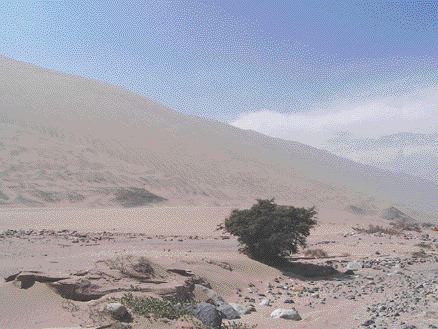Vancouver — Cardero Resource (CDU-V, CDY-X) is examining plans to commercially extract magnetite from its 320-sq.-km Iron Sands project in the coastal desert region of southern Peru.
Initial surface sampling has identified an aggregate area of about 15 sq. km (Pampa El Toro area) containing at least 5% magnetic minerals by weight in sand. In the Toro West section, an area of 7 sq. km contained a sampled average of 7.5% magnetics by weight, including higher grades of up to 9.9% magnetics by weight. The width of the higher-grade zone remains largely undefined, based on the current sample set.
Cardero collected a total of 172 surface samples from 135 sites in the Pampa El Toro area, on a widely spaced, 1,000 by 500-metre grid. In addition, 13 percussion boreholes were drilled on a widely spaced, 2-km grid with all but one sampling more than 100 metres of sand. Initial results of the borehole program indicate the magnetite content of the sands continues to at least 30 metres depth and remains homogenous. All samples were processed using a magnetic separator; analysis of the concentrates for total iron, titanium, vanadium and other constituents continues.
An independent engineering study and resource estimate is under way. Cardero envisages a potential large-scale mining operation which would see the magnetite-bearing sands extracted by bucket wheel excavators, belt wagons and ore conveyors to a dry magnetic separation plant producing at least a 60% (by weight) iron concentrate. The product could then be trucked to an iron plant, located near a deep-water port on the coast. The process would generally be an environmentally benign operation as the silica sand “waste” material would eventually be back-filled into the mined areas.
Magnetite samples from the Iron Sands project have been successfully tested through a Midrex Direct Reduction Process plant, producing a high-quality pig iron. The Midrex process converts iron ore into high-purity direct reduced iron (DRI) for use in steelmaking, ironmaking and foundry needs, and currently produces more than two-thirds of the world’s DRI. Midrex, a subsidiary of the Kobe Steel Group, also has two other proprietary processes of potential use to Cardero — Fastmet and Fastmelt.
Fastmet converts fine iron oxides into highly metallized DRI, with the addition of carbon (in the form of coal, charcoal or coke) to act as a reducing agent. The Fastmelt process involves feeding hot DRI from Fastmet into an electric melter to produce high-quality metal. It may also be feasible to recover byproduct titanium and vanadium from the waste slag in the production process.
The large Quaternary basin and active dune fields that comprise Iron Sands project area was first reviewed by the Peruvian government in the mid-1970s. The abundant magnetite within the sands are most likely weathered from the large IOCG (iron oxide-copper-gold) hardrock deposits in the region, including the large Chinese-operated Marcona iron mine, which contains a resource of about 1.4 billion tonnes grading 54% iron, and Cardero’s Pampa de Pongo deposit.
The company acquired Iron Sands in mid-2005 through staking.


Be the first to comment on "Cardero looks south for iron"